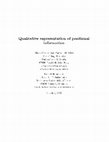Papers by daniel hernandez
We present mechanisms used to maintain the consistency of a knowledge base of spatial information... more We present mechanisms used to maintain the consistency of a knowledge base of spatial information based on a qualitative representation of 2-D positions. These include the propagation heuristics used when inserting new relations as well as the reason maintenance mechanisms necessary to undo the effects of propagation when deleting a relation. Both take advantage of the rich structure of the spatial domain.

Various relation-based systems, concerned with the qualitative representation and processing of s... more Various relation-based systems, concerned with the qualitative representation and processing of spatial knowledge, have been developed in numerous application domains. In this article, we identify the common concepts underlying qualitative spatial knowledge representation, we compare the representational properties of the different systems, and we outline the computational tasks involved in relation-based spatial information processing. We also describe symbolic spatial indexes, relation-based structures that combine several ideas in spatial knowledge representation. A symbolic spatial index is an array that preserves only a set of spatial relations among distinct objects in an image, called the modeling space; the index array discards information, such as shape and size of objects, and irrelevant spatial relations. The construction of a symbolic spatial index from an input image can be thought of as a transformation that keeps only a set of representative points needed to define the relations of the modeling space. By keeping the relative arrangements of the representative points in symbolic spatial indexes and discarding all other points, we maintain enough information to answer queries regarding the spatial relations of the modeling space without the need to access the initial image or an object database. Symbolic spatial indexes can be used to solve problems involving route planning, composition of spatial relations, and update operations.

Artificial Intelligence, 1997
A framework for the qualitative representation of positional information in a two-dimensional spa... more A framework for the qualitative representation of positional information in a two-dimensional space is presented. Qualitative representations use discrete quantity spaces, where a particular distinction is introduced only if it is relevant to the context being modeled. This allows us to build a flexible framework that accommodates various levels of granularity and scales of reasoning. Knowledge about position in large-scale space is commonly represented by a combination of orientation and distance relations, which we express in a particular frame of reference between a primary object and a reference object. While the representation of orientation comes out to be more straightforward, the model for distances requires that qualitative distance symbols be mapped to geometric intervals in order to be compared; this is done by defining structure relations that are able to handle, among others, order of magnitude relations; the frame of reference with its three components (distance system, scale, and type) captures the inherent context dependency of qualitative distances. The principal aim of the qualitative representation is to perform spatial reasoning: as a basic inference technique, algorithms for the composition of positional relations are developed with respect to same and different frames of reference. The model presented in this paper has potential applications in areas as diverse as Geographical Information Systems (GIS), Computer Aided Design (CAD), and Document Recognition.
A framework for the representation of qualitative distances is developed inspired by previous wor... more A framework for the representation of qualitative distances is developed inspired by previous work on qualitative orientation. It is based on the concept of “distance systems” consisting of a list of distance relations and a set of structure relations that describe how the distance relations in turn relate to each other. The framework is characterized by making the role of the “frame of reference” explicit, which captures contextual information essential for the representation of distances. The composition of distance relations as main inference mechanism to reason about distances within a given frame of reference is explained, in particular under “homogeneous structural restrictions”. Finally, we introduce articulation rules as a way to mediate between different frames of reference.
Discrete time, 25 KTPI track-following servos were designed for magnetic hard disk drive dual sta... more Discrete time, 25 KTPI track-following servos were designed for magnetic hard disk drive dual stage actuators using the μ-synthesis methodology. The design methodology was tested on two microactuator models. The first is a model of a piezoelectrically actuated suspension, under development by Hutchinson Technology Incorporated. The second is a model of an electrostatically actuated MEMS microactuator, under development by the IBM Almaden Research Center. Low order controllers were successfully designed for both models, which achieved the prescribed robustness and performance requirements











Uploads
Papers by daniel hernandez